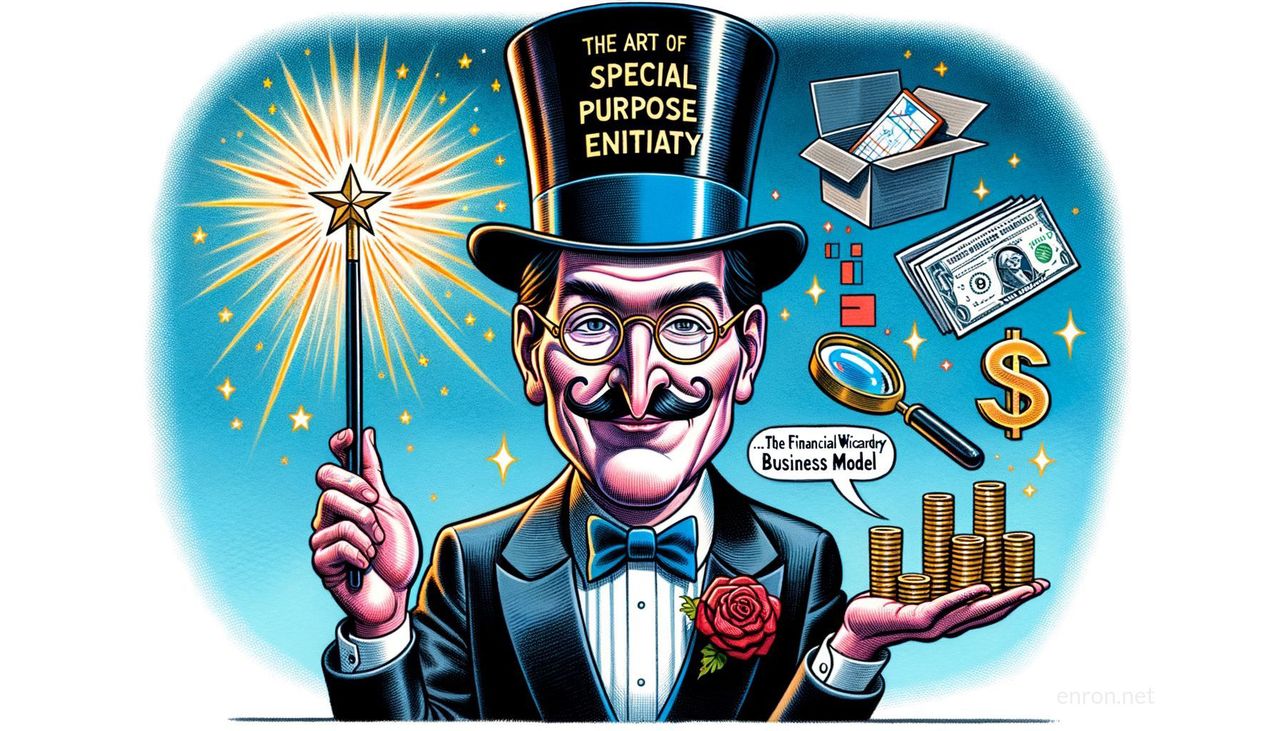Enron Unmasked: The Dark Art of Special Purpose Entities

Unveiling the Financial Alchemy That Powered Enron's Illusion
The Art of the Special Purpose Entity: The Financial Wizardry Behind Enron’s Business Model
Introduction: The Illusion of Invincibility
In the late 1990s, Enron Corporation stood as a colossus of corporate success, a paragon of American capitalism that had transitioned from a humble energy company to a seemingly invincible powerhouse in the world of trading and energy markets. Enron's stock soared, financial analysts sang its praises, and its executives basked in the glory of their ingenuity and foresight. But beneath this facade of success lay a labyrinthine network of financial machinations, the cornerstone of which were the Special Purpose Entities (SPEs) that would ultimately precipitate one of the most notorious corporate collapses in history.
The Genesis of Special Purpose Entities: Concept and Implementation
Special Purpose Entities, or SPEs, are a formidable financial instrument designed to isolate financial risk. The primary rationale behind creating an SPE is to distance a company's risky assets or operations from its primary business, thus protecting the core company from volatility and potential losses. This is achieved by creating a legally separate entity that holds these assets or engages in certain business activities.
In theory, SPEs provide legitimate financial benefits. They can be used for project financing, asset securitization, and risk management. However, the real danger arises when these financial tools are misused or manipulated, as was dramatically illustrated in the case of Enron.
Enron’s Financial Alchemy: The Rise of the SPE
Under the stewardship of Jeffrey Skilling and Andrew Fastow, Enron found a darker, more deceptive side to SPEs. Andrew Fastow, Enron’s Chief Financial Officer, was the architect behind Enron’s complex web of SPEs. The company established around 3,000 of these entities, notable among them being LJM1 and LJM2, which were named after Fastow’s wife and children—a personal and telling touch to an impersonal financial instrument.
Step by Step: How Enron Used SPEs to Manipulate Their Financials
The process Enron employed was complex yet devilishly effective:
-
Asset Transfer to SPEs: Enron would transfer poorly performing or risky assets to an SPE, ostensibly to detoxify its balance sheet. These assets included everything from stakes in power plants to broadband ventures that weren’t delivering returns.
-
Equity and Debt Off-Balance-Sheet: SPEs would be capitalized with a small amount of equity—sometimes from outside investors but often enough from Enron itself—and a large volume of debt that was guaranteed by Enron stock. These financial maneuvers allowed Enron to keep debt and losses off its own balance sheet, presenting a rosier financial picture to investors and analysts.
-
Revenue Recognition: By selling assets to the SPEs at inflated prices or by structuring complex transactions that lacked true economic substance, Enron could immediately recognize revenue. This created the illusion of profitability and sustained the high price of Enron stock.
-
Hedging Illusions: Enron executives used SPEs to set up what appeared to be hedge transactions, ostensibly to mitigate risk. However, these hedges were often circular and internal, using Enron’s own stock to guarantee performance. This meant that if Enron's stock fell, the SPEs would fail, further exacerbating Enron's financial troubles.
The Role of External Players: Complicity and Ignorance
It is impossible to tell the story of Enron’s fall without acknowledging the cadre of external accomplices. Investment banks, auditors, and even attorneys played pivotal roles, whether wittingly or unwittingly.
-
Investment Banks: Many leading banks facilitated the complex financial engineering needed to create and capitalize the SPEs, earning fees along the way. These institutions benefited enormously from Enron’s apparent success, complicating their willingness to scrutinize the underlying transactions critically.
-
Auditors: Arthur Andersen, Enron’s auditing firm, not only failed to raise alarms over the opaque and questionable accounting practices but actively helped obscure the true state of Enron’s finances. When the scandal broke, Arthur Andersen faced its downfall just as Enron did.
The House of Cards Collapses: The Unraveling
In late 2001, the intricate web of SPEs began to unravel. Enron’s facade of success crumbled as it disclosed that it had overstated earnings by nearly $600 million since 1997. Concurrently, the collapse of Enron’s stock—integral to the structure of most SSEs—rendered the guarantees worthless and created an immediate cash crisis.
Revelations of the SPE manipulations, combined with a cascade of financial restatements, led to a collapse in investor confidence. By December 2, 2001, Enron filed for bankruptcy, marking the largest corporate bankruptcy in U.S. history at that time.
Aftermath and Lessons Learned: A Cautionary Tale
The Enron scandal precipitated widespread regulatory and legislative changes, most notably the Sarbanes-Oxley Act of 2002, which introduced stringent reforms to improve corporate governance and transparency. Enron’s use of SPEs served as a glaring example of how financial instruments, when abused, can conceal the true risks and distort financial reality.
In addition to legislative changes, the ethical dimension of corporate governance came under scrutiny. Enron’s downfall underscored the importance of ethics, transparency, and accountability in corporate stewardship.
Conclusion: The Legacy of Enron’s Financial Wizardry
Enron’s story is a testament to the power and peril of financial innovation. While Special Purpose Entities can serve legitimate business purposes, their manipulation can lead to staggering consequences. The Enron scandal remains a stark reminder of how the pursuit of financial wizardry, void of ethical considerations, can culminate in catastrophic collapse. It is a sobering chapter in corporate history that continues to resonate and inform modern financial regulation and corporate ethics.